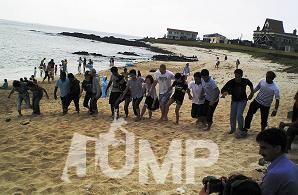By Jamil Ahmed Chaudhry, Ph.D. student in Department of Tourism Management
When I tried to open the door of International Kitchen of the university at 6 AM on the morning of our schedule visit to Udo Islands, it refused to open despite my best efforts. I swapped my card against the digital lock repeatedly but it could not budge the door. Perhaps, the housekeeper had locked it manually previous night. I came back to my room and gulped down a sandwich, as I have to prepare for my first trip to the Island. The cool mid-September day was beautiful.
Reaching Ara Muse Hall, I found a group of Chinese students waiting for rest of their friends. Being a newcomer in the campus, I could not find a familiar face in the group; therefore, I looked around to find a place to wait for others. There, I saw a man approaching from Student Union Building. ‘Hi, how do you do?’, he greeted me with smile and there began a small talk. After that, we finally set off the Udo which means 'cow-shaped' island in the east.

Setting foot on the Udo, I realized that the island is not that large as I imagined. On leaving the harbor for inner part on the bus, I could see coloured rooftops of small houses on hillocks on the edges of prairies and small farms. The island is nothing but a piece of heaven on the earth. The terrain features uneven lush green spots punctuated with grey mounds, grazing land, thick clumps of tall pine trees and long narrow trails.
After reaching at a staging spot, we started exploring the place in groups. Along with Mr. Danial King- a West Indian professor teaching Veterinary Medicines I followed along a track, paved with well-knit pieces of rubber (used tires), heading to the ridge with lighthouses. It was a hot and humid day. After covering some kilometers, we were searching for water and shade. Soon, we reached the lighthouse and found that it was barricaded. We had to detour to continue our journey to other parts of the island. The retreat led us to discover a small restaurant- a treat on a lonely planet! I quenched my thirst with cold packed milk and took a refrigerated bottle of water for rest of the time on the track.
I was amazed to notice a small building on the top of the ridge housing, a museum! A number of photographs and illustrations depicting life on the island are the only collections. It offers to folks touching the outer post of South Korea. This point of the island also provides perfect opportunity to view the whole of the area stretched over 17 kilometers in circumference. We could see cows grazing, here and there. Small fishing farms surrounded by stone houses, and buses vying different routs could be spotted in the length and breadth of the small island.
Trekking further down the ridge, we caught other members of the student community fighting for space at a tiny roadside shop. Everybody was tired and looking for a respite. The long walk over the ups and downs of the island has dehydrated our bodies considerably ,and our reserved energies were undermined. It was particularly apparent on the dismal looks of the young participants. It was time to have lunch.
The place has a number of small restaurants, eateries, shops etc. We were lucky to find food of our choice at one place. The seafood is the specialty of the island and one of my personal favorite food giving our appetite. The sumptuous food was not only delicious but also best in caloric counts. For further trip, we were having the moment. Then we headed for the coral beach with white sands. The travelers from the university made two teams to compete in a match for fun on the shoreline. The winners were awarded with chocolate bars. The beach provided the perfect place for fun, relaxation and retreat. People who could not endure long walks could borrow tricycles and cycles to enjoy hidden corners of the island.

Besides its beauty, the island is also known for its hearty diving women who were once enjoying dominant power in a society dependent upon sea resources such as fish, crabs, shrimps, seaweed, etc. Their status and services are recognized and marked with a statue erected on the beach.

